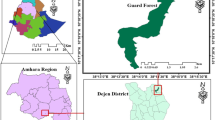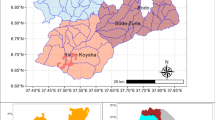Abstract
If specialization influences species presence, then high tropical tree and shrub diversity should correspond with high environmental heterogeneity. Such heterogeneity may be found among different successional communities (i.e., canopy types). We explore species associations in three forest-dominated canopy types, forest, gap, and edge, in Kibale National Park, Uganda and determine environmental, soil and light, differences among canopy types. To determine the strength of differences among forested canopy types, they are also compared to grasslands. Tree and shrub density and species richness using rarefaction analysis were determined based on data from 24 small plots (5 × 5 m) in all four canopy types and 16 large plots (10 × 50 m) in forest and grassland canopy types. Environmental variables were determined along 10 (20 m) transects in the four canopy types. Using analysis of variance and principal components analysis, we demonstrate that forest and gap environments had similar soils, but forest had lower light levels than gap. We also found that grassland and edge were more similar to one another than to forest and gap, but differed in a number of important biotic and abiotic factors controlling soil water availability (e.g., edge had higher root length density of small roots < 2 mm diameter in the top 20 cm than grassland). Using principal components analysis to assess similarities in community composition, we demonstrate that gap and forest had indistinguishable communities and that edge was similar to but distinct from both communities. Complete species turnover only occurred between grassland and the three forested canopy types. Even though overall community composition was similar in the three forested canopy types, in analyses of individual species using randomization tests, many common species were most frequently found in only one canopy type; these patterns held across size classes. These results suggest that despite differences among environments, community composition was similar among forested canopy types, which are likely intergrading into one another. Interestingly, individual species are more frequently found in a single canopy type, indicating species specialization.
Similar content being viewed by others
References
V.K. Agyeman M.D. Swaine J. Thompson (1999) ArticleTitleResponses of tropical forest tree seedlings to irradiance and the derivation of a light response index J. Ecol. 87 815–827 Occurrence Handle10.1046/j.1365-2745.1999.00400.x
F. Bongers L. Poorter R.S.A.R. Van Rompaey M.P.E. Parren (1999) ArticleTitleDistribution of twelve moist forest canopy tree species in Liberia and Cote d’Ivoire: response curves to a climatic gradient J. Veg. Sci. 10 371–382
N. Brokaw (1982) ArticleTitleThe definition of treefall gap and its effect on measures of forest dynamics Biotropica 14 158–160
N. Brokaw R.T. Busing (2000) ArticleTitleNiche versus chance and tree diversity in forest gaps Trends Ecol. Evol. 15 183–188 Occurrence Handle10.1016/S0169-5347(00)01822-X Occurrence Handle10782131
J. Brzustowski (2002) Accessed 9 May 2002. Rarefaction Calculator University of Alberta Alberta
D.F.R.P. Burslem (1996) Differential responses to nutrients, shade and drought among tree seedlings of lowland tropical forest in Singapore M.D. Swaine (Eds) The Ecology of Tropical Forest Tree Seedlings UNESCO Paris 211–244
C.A. Chapman J.E. Lambert (2000) ArticleTitleHabitat alteration and the conservation of African primates: case study of Kibale National Park, Uganda Am. J. Primatol. 50 169–185 Occurrence Handle10.1002/(SICI)1098-2345(200003)50:3<169::AID-AJP1>3.0.CO;2-P Occurrence Handle10711532
P. Chesson N. Huntly (1997) ArticleTitleThe roles of harsh and fluctuating conditions in the dynamics of ecological communities Am. Nat. 150 519–553 Occurrence Handle10.1086/286080
D.B. Clark M.W. Palmer D.A. Clark (1999) ArticleTitleEdaphic factors and the landscape-scale distributions of tropical rain forest trees Ecology 80 2622–2675
J.H. Connell (1978) ArticleTitleDiversity in tropical rain forests and coral reefs: high diversity of trees and corals is maintained only in a non-equilibrium state Science 199 1302–1310
L.M.T. de Carvalho M.A.L. Fontes A.T. de Oliveira-Filho (2000) ArticleTitleTree species distribution in canopy gaps and mature forest in an area of cloud forest of the Ibitipoca Range south-eastern Brazil Plant Ecol. 149 9–22 Occurrence Handle10.1023/A:1009836810707
N.J. Gotelli R.K. Colwell (2001) ArticleTitleQuantifying biodiversity: procedures and pitfalls in the measurement and comparison of species richness Ecol. Lett. 4 379–391 Occurrence Handle10.1046/j.1461-0248.2001.00230.x
P.J. Grubb (1977) ArticleTitleThe maintenance of species-richness in plant communities: the importance of the regeneration niche Biol. Rev. Cambridge Philos. Soc. 52 107–145
P.J. Grubb (1996) Rainforest dynamics: the need for new paradigms D.S. Edwards W.E. Booth S.C. Choy (Eds) Tropical Rainforest Research – Current Issues Kluwer Academic Dordrecht 215–233
A. Hamilton (1991) A Field Guide to Ugandan Forest Trees Makerere University Press Kampala
K.E. Harms R. Condit S.P. Hubbell R.B. Foster (2001) ArticleTitleHabitat associations of trees and shrubs in a 50-ha neotropical forest plot J. Ecol. 89 947–959
P.C. Howard (1991) Nature Conservation in Uganda’s Tropical Forest Reserves IUCN Publications Services Unit Cambridge
S.P. Hubbell (1997) ArticleTitleA unified theory of biogeography and relative species abundance and its application to tropical rain forests and coral reefs Coral Reefs 16 S9–S21 Occurrence Handle10.1007/s003380050237
S.P. Hubbell R.B. Foster (1986) Commonness and rarity in a Neotropical forest: implications for tropical tree conservation M.E. Soule (Eds) Conservation Biology: The Science of Scarcity and Diverstiy Sinauer Associates Sunderland 205–231
S.H. Hurlbert (1971) ArticleTitleThe non-concept of species diversity: a critique and alternative parameters Ecology 52 577–586
R.H. Jongman C.J.F. ter Braak O.F.R. van Tongeren (1987) Data Analysis in Community and Landscape Ecology Pudoc Wageningen Wageningen
J.R. Kamugisha (1993) Management of Natural Resources and Environment in Uganda: Policy and Legislation Landmarks, 1890–1990 Regional Soil Conservation Unit Nairobi
M. Kappelle P.A.F. Kennis R.A.J. Devries (1995) ArticleTitleChanges in diversity along a successional gradient in a Costa Rican upper montane Quercus forest Biodiv. Conserv. 4 10–34 Occurrence Handle10.1007/BF00115312
Kasenene J.M. 1987. The influence of mechanized selective logging, felling intensity and gap-size on the regeneration of a tropical moist forest in the Kibale Forest ReserveUganda. Ph.D. Thesis, Michigan State University, East Lansing.
A.B. Katende A. Birnie B. Tengnäs (1995) Useful Trees and Shrubs for Uganda: Identification, Propagation, and Management for Agricultural and Pastoral Communities Regional Soil Consultants Unit Nairobi
B. Kingston (1967) Working plan for the Kibale and Itwara Central Forest Reserves Government of Uganda Printer Entebbe
D. Kirkwood J.J. Midgley (1999) ArticleTitleThe floristics of sand forest in northern KwaZulu-Natal, South Africa Bothalia 29 293–304
A. Klute (1986) Methods of Soil Analysis Part 1: Physical and Mineralogical Methods Soil Science Society of America Madison
C.J. Krebs (1989) Ecological Methodology Harper & Row New York
J.R. Lang Brown J.F. Harrop (1962) ArticleTitleThe ecology and soils of the Kibale grasslands, Uganda East Afr. Agr. Forestry J. 27 264–272
I. Langdale-Brown H.A. Osmaston J.G. Wilson (1964) The Vegetation of Uganda and its Bearing on Land Use Government of Uganda Report Government Printer Entebbe
M. Lieberman D. Lieberman R. Peralta G.S. Hartshorn (1995) ArticleTitleCanopy closure and the distribution of tropical forest tree species at La Selva Costa Rica J. Tropical Ecol. 11 161–178
J. Lwanga (1996) Trees and shrubs P. Howard T. Davenport R. Matthews (Eds) Kibale Forest Biodiversity Report Forest Department Kampala 15–36
Munsell Colour Company 1975. Munsell Soil Colour Charts. Munsell Colour Macbeth Division of Kollmorgen Corp, Baltimore.
M.J. Norusis (1994) SPSS: SPSS Advanced Statistics 6.1. SPSS Inc. Chicago
M. Oosterhoorn M. Kappelle (2000) ArticleTitleVegetation structure and composition along an interior-edge-exterior gradient in a Costa Rican montane cloud forest Forest Ecol. Manage. 126 291–307 Occurrence Handle10.1016/S0378-1127(99)00101-2
A.L. Page R.H. Miller D.R. Keeney (1982) Methods of Soil Analysis Part 2: Chemical and Microbiological Properties Soil Science Society of America Madison
Paul J.R.,Randle A.M.,Chapman C.A.and Chapman L.J. Arrested succession in logging gaps:is tree seedling growth and survival limiting?.Afr.J.Ecol.In press.
O.L. Phillips P. Hall A.H. Gentry S.A. Sawyer R. Vasquez (1994) ArticleTitleDynamics and species richness of tropical rain forests Proc. National Academy Sci. United States Am. 91 2805–2809
N.C.A. Pitman J. Terborgh M.R. Silman P. Nuez (1999) ArticleTitleTree species distributions in an upper Amazonian forest Ecology 80 2651–2661
R.M. Polhill (1952) Flora of Tropical East Africa A.A. Balkema Rotterdam
R Development Core Team 2002. R 1.6.2. Free Software Foundation, Inc., Boston. www.r-project.org
J.W. Raich N.L. Christensen (1989) ArticleTitleMalaysian dipterocarp forest – tree seedling and sapling species composition and small-scale disturbance patterns Natl. Geogr. Res. 5 348–363
S.A. Schnitzer W.P. Carson (2001) ArticleTitleTreefall gaps and the maintenance of species diversity in a tropical forest Ecology 82 913–919
D. Sheil (1999) ArticleTitleDeveloping tests of successional hypotheses with size-structured populations, and an assessment using long-term data from a Ugandan rain forest Plant Ecol. 140 117–127 Occurrence Handle10.1023/A:1009729108668
D.S. Simberloff (1972) ArticleTitleProperties of the rarefaction diversity measurement Am. Nat. 106 414–418 Occurrence Handle10.1086/282781
J.P. Skorupa J.M. Kasenene (1984) ArticleTitleTropical forest management: can rates of natural treefalls help guide us? Oryx 18 96–101
T.T. Struhsaker (1997) Ecology of an African rain forest: logging in Kibale and the conflict between conservation and exploitation University Press of Florida Gainesville
J.C. Svenning (1999) ArticleTitleMicrohabitat specialization in a species-rich palm community in Amazonian Ecuador J. Ecol. 87 55–65 Occurrence Handle10.1046/j.1365-2745.1999.00329.x
M.D. Swaine (1996) ArticleTitleRainfall and soil fertility as factors limiting forest species distributions in Ghana J. Ecol. 84 419–428
M.D. Swaine T.C. Whitmore (1988) ArticleTitleOn the definition of ecological species groups in tropical rain forests Vegetatio 75 81–86 Occurrence Handle10.1007/BF00044629
C.J.F. ter Braak P. Smilauer (1999) Canoco for Windows 4.02. Centre for Biometry Wageningen Wageningen
J. Terborgh R.B. Foster P. Nunez (1996) ArticleTitleTropical tree communities: a test of the nonequilibrium hypothesis Ecology 77 561–567
C. Uhl K. Clark N. Dezzeo P. Maquirino (1988) ArticleTitleVegetation Dynamics in Amazonian Treefall Gaps Ecology 69 751–763
C.O. Webb D.R. Peart (2000) ArticleTitleHabitat associations of trees and seedlings in a Bornean rain forest J. Ecol. 88 464–478 Occurrence Handle10.1046/j.1365-2745.2000.00462.x
G. Williams-Linera V. Dominguez-Gastelu M.E. Garcia-Zurita (1998) ArticleTitleMicroenvironment and floristics of different edges in a fragmented tropical rainforest Conserv. Biol. 12 1091–1102 Occurrence Handle10.1046/j.1523-1739.1998.97262.x
L.D. Wing I.O. Buss (1970) ArticleTitleElephants and forests Wildlife Monogr. 19 1–91
S.J. Wright (2002) ArticleTitlePlant diversity in tropical forests: a review of mechanisms of species coexistence Oecologia 130 1–14
A.E. Zanne C.A. Chapman (2001) ArticleTitleExpediting reforestation in tropical grasslands: distance and isolation from seed sources in plantations Ecol. Appl. 11 1610–1621
Author information
Authors and Affiliations
Corresponding author
Rights and permissions
About this article
Cite this article
Zanne, A.E., Chapman, C.A. Diversity of woody species in forest, treefall gaps, and edge in Kibale National Park, Uganda. Plant Ecol 178, 121–139 (2005). https://doi.org/10.1007/s11258-004-2562-z
Received:
Accepted:
Issue Date:
DOI: https://doi.org/10.1007/s11258-004-2562-z




